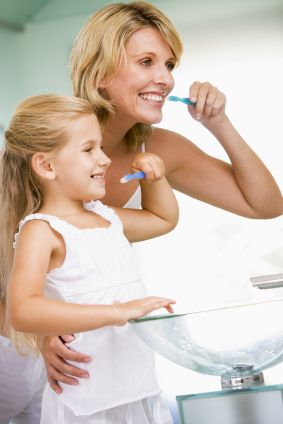 The food residues remaining on the teeth after each meal start to form dental plaque (which mineralizes, turning into tartar). The cavity is a bacterial disease, with food and hygiene as factors causing its occurrence and evolution.
The food residues remaining on the teeth after each meal start to form dental plaque (which mineralizes, turning into tartar). The cavity is a bacterial disease, with food and hygiene as factors causing its occurrence and evolution.
Tooth brushing is indicated after each meal or at least in the morning and at night. It is mandatory to brush your teeth at night, after dinner, before going to bed, because the dental plaque and food residues maintained on the teeth throughout the night favour the multiplication of bacteria, the demineralization of the enamel and the inflammation of the gums.
Here’s how teeth are brushed correctly:
- it is indicated to brush the upper and the lower dental arcade separately, with wide, vertical motions, from the gum towards the tooth;
- the motions must be relaxed, using the wrist, 7-8 motions per each dental group;
- brush the external surface of the teeth (starting from the cheek), the internal surface of the teeth (starting from the hard palate), the tongue and the mastication surfaces of the teeth;
- when rinsing, close the lips and pass the water through the teeth, using the cheek muscles for pressure. Then spit the water. Repeat the procedure 3-4 times;
- correct and complete brushing must last for 3-5 minutes.
Toothpaste:
The majority of toothpastes contain slightly abrasive substances, fluoride, antiseptic substances, or even anaesthetic substances.
Dental floss:
- it is recommended to use dental floss once a day, between the teeth with a contact point;
- the dental floss removes the dental plaque and food residues from the interdental spaces, where the toothbrush cannot reach, even if used correctly;
- it reduces the risk of interdental cavities by over 50% and prevents the occurrence of gingival inflammation;
- use as follows: prepare 20-25 cm long thread, which is rolled between the middle fingers of the hand, leaving a 2-3 cm portion free. Use the thumbs to pull the thread on the upper dental arcade, and the pointer fingers to pull the thread on the lower dental arcade. Insert the tense thread in between the teeth, and apply controlled pressure until going past the interdental point, in order to avoid damaging the gum. The thread is hold in tension and slightly curved on the surface of the tooth, being moved up and down 3-4 times along the tooth. After using a piece of it, roll the thread on the fingers, to have an unused portion at hand. Resume the procedure. Remember to clean the back surface of the last molar (the back tooth).
Interdental brush:
- it is used for larger interdental spaces, where the dental floss is inefficient (interdental spacing, bone resorptions, the area surrounding the tooth implant);
- it is recommended for people wearing dental bridges and fixed orthodontic appliances.
Electric toothbrush:
It is recommended for children who lack the ability and the patience required to brush correctly, but it can also be used by adults who want to make tooth brushing easier.
Manual toothbrush:
The toothbrush bristles must be averagely hard (for most people) or soft (for people with periodontal issues or sensitive gums). Remember that the toothbrush must be replaced with a new one every 3-4 months.
Oral irrigator:
- it is a device which projects a pulsating jet of water over the teeth, at various pressure levels, through a cannula;
- the water jet is oriented between and around the teeth, to remove the soft residues and part of the dental plaque, also executing a gum massage;
- it is a procedure which is adjuvant to tooth brushing, but cannot replace it.

